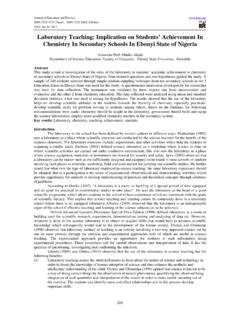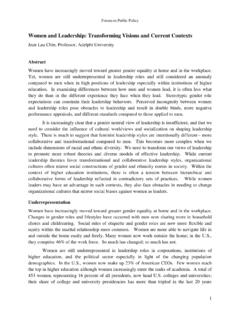Transcription of Problems and Solutions when Dealing with Street Children
1 A qualitative study based on experiences from Social Workers' in Bloemfontein, South Africa. CANDIDATE THESIS MAJOR: Social Work AUTHORS: Amanda Friberg & Viktoria Martinsson J NK PING 2017 Problems and Solutions when Dealing with Street Children 2 Abstract Based on qualitative interviews with social workers is the aim with this study to examine a social worker's perspective concerning their work and development with Street Children in Bloemfontein, South Africa. The interviews were analyzed thematically focusing on how social workers describe the Problems and their work/strategies with Street Children . The result is divided in two themes; Problems and Solution. Problems refer to how the local context concerning Street Children in Bloemfontein are described by social workers. Solutions refer to how the social workers describe their work and which Solutions that are available in Bloemfontein.
2 According to the participant s Street Children are viewed as victims, thief s and naughty by the society. The social workers stated that the main approach of effort in social work with Street Children are trustful-relationships, negotiation and support. Therefore, a relationship of trust must be gained before the Children can receive help. The participants divided Children of the Street in to types, the manipulative child and the naive child. The social worker s tasks are to work with both types of Children in order to create change and to restore trust. The findings from the result are analyzed from one of Helen Fuchs Bach s theoretical concepts from The Exit Process. This concept is called the Turning Point and refers to that there comes a point where a change is needed which affects the former identity and role for a person. Understanding the results using the Turing Point has helped us understand the importance of creating trusting relationships and making each Street child feel special in order to enable change in a Street child s life.
3 Keywords: Street Children , South Africa, Social work, Social work process, Qualitative study, Bloemfontein 3 Content ABSTRACT .. 2 1. INTRODUCTION .. 5 2. BACKGROUND .. 7 Street CHILD .. 7 SOCIAL WORK .. 7 SOCIAL WORKER .. 7 SOCIAL DEVELOPMENT .. 8 COMMUNITY WORK .. 8 NON-GOVERNMENTAL ORGANIZATION (NGO) .. 8 NON-PROFIT ORGANIZATION (NPO) .. 9 3. FORMER RESEARCH .. 10 Children LIVING ON THE Street .. 10 PUSH-FACTORS FOR BECOMING A Street CHILD .. 11 AMOUNT AND GENDER .. 12 SHELTERS FOR Street Children .. 13 ADJUST SETBACKS .. 13 4. THEORETICAL TOOL .. 15 THE TURNING POINT .. 16 5. METHODS .. 18 SAMPLE .. 18 SEMI-STRUCTURED INTERVIEW .. 19 CONSTRUCTING THE INTERVIEW GUIDE .. 19 COLLECTING THE DATA .. 19 TRANSCRIPTS OF INTERVIEWS .. 20 THEMATIC ANALYSIS .. 20 RELIABILITY AND VALIDITY .. 21 ETHICAL CONSIDERATIONS .. 22 LIMITATIONS .. 23 6. RESULTS - Problems AND Solutions .. 25 Problems .
4 25 Local Context .. 25 The Quick Fix .. 28 Family Relationships .. 29 Streetwise .. 30 Solutions .. 31 The Organizations .. 31 Preventive Work as an Effort .. 32 The Possibility of Making a Difference .. 34 Genders Methods .. 36 4 Family-based Work .. 36 Strategies in the Work with Street Children .. 37 7. DISCUSSION .. 42 PUSH-FACTORS AND PULL-FACTORS .. 43 TURNING POINT .. 44 FURTHER RESEARCH .. 48 METHODOLOGY DISCUSSION .. 48 8. 50 REFERENCES .. 51 APPENDIX 1 .. 54 5 1. Introduction De brito (2014) describe Street Children as a major social problem in some countries and the importance to acknowledge the issue. To change global development of the Problems with Street Children , the problem must first be highlighted. According to UNICEF (De brito, 2014) there are tens of millions of Street Children all around the world. In South Africa, many Children made the Street their home or at least spend most time outside their homes.
5 This study is providing knowledge about the phenomena of Street Children in Bloemfontein, South Africa. Giddens (2014) describe that most people in today s society see childhood in a process of becoming an adult. Childhood includes a content of social and structural positions in different communities depending on where a child is growing up. Childhood is nowadays no longer a universal social construction; it depends on the experiences a child gets in the society. The sociology has left the functional perspective of childhood and has begun to see Children as active participants in constructing their own lives in society. Giddens (2014) writes that Children whom is exposed to physical and physical violence at home do not have the luxury of a caretaking family. The life of a Street child is a life of constantly trying to survive on the Street . In other words, are Street Children active participants in construction their life.
6 Street Children s living situation is filled with difficulties and often related with drug abuse, violence, crime, family disruption, abandonment, disease, prostitution, and so forth (De brito, 2014). According to Ward and Seger (2010) is there a lack of knowledge and information about how to change Street Children s situation for the better especially concerning methods and strategies of how to deal with these Children . Ward and Seger (2010) further describe the lack of support from the government in South Africa, which put pressure on the Non-governmental organizations (NGOs) and Non-profit organizations (NPOs) to handle the issues. This is the case in Bloemfontein where this study was conducted, and means that Street Children are usually relying on community work and often get help from non-governmental organizations. This study is based on interviews with individuals who perform social worker with Street Children in such circumstances in Bloemfontein, South Africa.
7 The aim with this study is to examine a social worker's perspective concerning their work and development with Street Children in Bloemfontein, South Africa. Our primarily purpose is to 6 gain knowledge about how the social workers describe their work in the local context with Street Children . Further, we will also detect methods and strategies that are utilized in the process of Street Children leaving the Street . And how the social workers express their effort to prevent Children from living on the streets in South Africa (SA). More precisely will the following questions be discussed: 1/ How do the social workers describe the local context concerning Street Children in Bloemfontein, SA? 2/ How do the social workers describe their work and which Solutions are available in Bloemfontein, SA? The social worker's perspective explored in the results is later on analyzed by a theoretical tool/stage called the turning point from Helen Fuchs Bach s (1988) theory The Exit Process.
8 More precisely will a certain stage in the exit process called the Turning Point be used. The Turning Point is defined by identifying behavioral changes that are needed in order to survive, or to adjust to different environments. Understanding the results using the Turing Point will develop our understanding for the process behind the work, which is to reach a stage in a Street child s life where everything changes. 7 2. Background This part includes definitions of concepts that are of importance for understanding this study. The selection of the concepts is based on which terms the participants used. Street Child UNICEF (2001) defined a Street child as any boy or girl who has not reached adulthood, for whom the Street has become her or his habitual abode and/ or sources of livelihood, one who is inadequately protected, supervised or directed by responsible adults. What is clear from the above definition of a Street child is that such a child leaves home to stay on the Street and the Street not only becomes the child s home but also the source of a living.
9 Such a child assumes full responsibilities on his or her own life. Street Children are further as either on the Street or of the Street . Children of the Street live and sleep on the streets in urban areas and streets are their homes whereas Children on the Street have their homes and only come to the streets to beg for money during the day and return home in the evening. The former group has no contact with family while the latter lives with family (Chireshe, Jadezweni, Cekiso, et al, 2014). Our research and interviews are focused on both Children of the Street and Children on the Street , as the organization's work with both. Social Work Social work is practiced by educated social workers with the aim of improving conditions for people suffering from social deprivation. To apply theories regarding social systems and human behavior, social work engages in the interaction between people and their environments.
10 The principles of human rights and social justice are fundamental in order to perform social work (Hare, 2000). Social Worker The social work profession promotes problem-solving concerning human relationships, social change and provide liberation and empowerment to people to enhance wellbeing. The profession of a social worker practice injustices and barriers that exist in the society at an everyday basis. It utilizes a variety of skills such as different techniques and activities consistent with a holistic focus on persons and their environments. Social workers practice 8 counseling, clinical social work, group work, social pedagogical work, family treatment and therapy, as well as different efforts to help people obtain resources and services in the community. It also includes engaging in the social and political actions to impact the social development (Hare, 2000).












